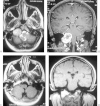Management of hypoglossal schwannomas: single institutional experience of 14 cases
- PMID: 25072009
- PMCID: PMC4078147
- DOI: 10.1055/s-0033-1356924
Management of hypoglossal schwannomas: single institutional experience of 14 cases
Abstract
Background Hypoglossal schwannomas are rare intracranial neoplasms. Microsurgical resection with the goal of cure is the aim of management but is associated with a high rate of postoperative morbidity. Objective The objective of the study was to outline the clinical presentation, radiologic characteristics, surgical techniques, postoperative morbidity, and long-term follow-up results for hypoglossal schwannomas. Methods Patients treated for hypoglossal schwannoma at the Department of Neurosurgery of a tertiary-level referral institution from January 2001 until December 2010 were analyzed retrospectively using hospital records. Results There were 14 patients who were treated in the study period. Tongue atrophy and swallowing difficulties were the most common presenting symptoms. Surgery done in 12 patients using a variety of approaches (retromastoid retrosigmoid suboccipital in 9, midline suboccipital in 2, and far lateral in 1). Five patients having small residual tumors received gamma knife (GK) subsequently. two patients received primary GK stereotactic radiosurgery. Three patients had permanent morbidity in the form of cranial nerve paresis. Immediate postoperative complications like cerebrospinal fluid leak and pneumonia were present in three patients. Conclusion Complete microsurgical resection is often associated with a high rate of morbidity. Subtotal and near-total resection followed by stereotactic radiosurgery or observation now offers an alternative approach.
Keywords: gamma knife; hypoglossal canal; schwannoma; skull base tumors; twelfth nerve.
Figures

Similar articles
-
Intradural microsurgery and extradural gamma knife surgery for hypoglossal schwannoma: case report and review of the literature.Minim Invasive Neurosurg. 2007 Dec;50(6):374-8. doi: 10.1055/s-2007-993206. Minim Invasive Neurosurg. 2007. PMID: 18210363 Review.
-
Microsurgical management of hypoglossal schwannomas over 3 decades: a modified grading scale to guide surgical approach.Neurosurgery. 2011 Dec;69(2 Suppl Operative):ons121-40; discussion ons140. doi: 10.1227/NEU.0b013e31822a547b. Neurosurgery. 2011. PMID: 21709593 Review.
-
Optimal treatment of jugular foramen schwannomas: long-term outcome of a multidisciplinary approach for a series of 29 cases in a single institute.Acta Neurochir (Wien). 2017 Aug;159(8):1517-1527. doi: 10.1007/s00701-017-3230-0. Epub 2017 Jun 6. Acta Neurochir (Wien). 2017. PMID: 28589468
-
Surgical management and outcome of schwannomas in the craniocervical region.J Neurosurg. 2011 May;114(5):1257-67. doi: 10.3171/2010.5.JNS0966. Epub 2010 Jul 9. J Neurosurg. 2011. PMID: 20617880
-
A Single-Institution Retrospective Study of Jugular Foramen Schwannoma Management: Radical Resection Versus Subtotal Intracranial Resection Through a Retrosigmoid Suboccipital Approach Followed by Radiosurgery.World Neurosurg. 2016 Apr;88:552-562. doi: 10.1016/j.wneu.2015.10.042. Epub 2015 Oct 28. World Neurosurg. 2016. PMID: 26520430
Cited by
-
Extracranial Hypoglossal Schwannoma: Case Report and Literature Review.In Vivo. 2024 May-Jun;38(3):1489-1497. doi: 10.21873/invivo.13596. In Vivo. 2024. PMID: 38688631 Free PMC article. Review.
-
Dumbbell-shaped solid-cystic hypoglossal schwannoma: An unusual case report.Radiol Case Rep. 2022 Jan 18;17(3):967-969. doi: 10.1016/j.radcr.2021.12.044. eCollection 2022 Mar. Radiol Case Rep. 2022. PMID: 35106105 Free PMC article.
-
Trends in the Management of Non-Vestibular Skull Base and Intracranial Schwannomas.Cancer Manag Res. 2021 Jan 18;13:463-478. doi: 10.2147/CMAR.S287410. eCollection 2021. Cancer Manag Res. 2021. PMID: 33500660 Free PMC article. Review.
-
Stereotactic radiosurgery for hypoglossal schwannoma.BMJ Case Rep. 2022 Apr 11;15(4):e244849. doi: 10.1136/bcr-2021-244849. BMJ Case Rep. 2022. PMID: 35410946 Free PMC article.
-
Extracranial hypoglossal neurofibroma with a variant ansa cervicalis: a case report.Surg Radiol Anat. 2023 Mar;45(3):297-302. doi: 10.1007/s00276-023-03085-z. Epub 2023 Feb 1. Surg Radiol Anat. 2023. PMID: 36723635
References
-
- De Martel T, Subirana G J. Los tumors de la fosa cerebral posterior: voluminoso neurinoma del hipogloso con desarrelle juxtabulbo-protuberencial. Operacion-curacion. Ars Med. 1933;9:416–419.
-
- Ho K L. Schwannoma of the trochlear nerve. Case report. J Neurosurg. 1981;55(1):132–135. - PubMed
-
- Sutay S, Tekinsoy B, Ceryan K, Aksu Y. Submaxillary hypoglossal neurilemmoma. J Laryngol Otol. 1993;107(10):953–954. - PubMed
-
- Hoshi M, Yoshida K, Ogawa K, Kawase T. Hypoglossal neurinoma—two case reports. Neurol Med Chir (Tokyo) 2000;40(9):489–493. - PubMed
-
- Chang K C, Leu Y S. Hypoglossal schwannoma in the submandibular space. J Laryngol Otol. 2002;116(1):63–64. - PubMed
LinkOut - more resources
Full Text Sources
Other Literature Sources

